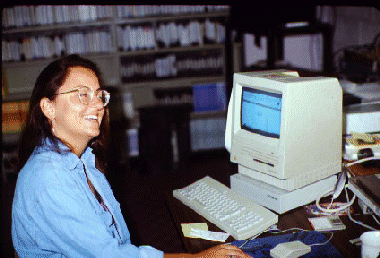
Summer in Majuro
by Ari Lee Seligmann
I spent my summer as a technical assistant in the Marshall Islands. My job was to train journalists who produce several newsletters for the government. My primary task was to transfer editing and writing skills to the managing editor of the RMI Gazette, a monthly newsletter that serves the government. Other newsletters I had the opportunity to assist with were the Education Newsletter and a new newsletter for the Head Start Program.
With the Head Start Program, my job consisted mainly of training staff members in computer skills, including word processing and desktop publishing. We designed a newsletter that would be written in both Marshallese and English. A longtime Head Start employee, Bima Akeke, was the designated reporter who would collect articles, and cleric Sally Capelle was chosen to take care of administrative tasks, such as typing and computer layout. Morris Jetnil, another Head Start employee, was chosen to assist in the production of the newsletter. The three participants eagerly attended the early morning computer training sessions and even more eagerly awaited coffee breaks when we had a particularly difficult lesson!
My afternoons were spent working with the producers of the RMI Gazette. I transferred skills in writing, editing, and computer operations to my counterpart Florian Helkena, the managing editor. I also had the opportunity to work with Sam Jordan, known as Big Sam, a seasoned radio veteran who did a weekly education show on the radio and collected stories for the Gazette.
Communications for the government are administered by the Ministry of Education. State of the art video technology and a fully operational print shop are located near the high school. My office was in the media center, the hub of activity for government-requested videotaping and photographing of important events. I was fortunate to be in a position to attend many government events with a press pass.
Although work was the center of my life in Majuro, it wasn't all work and no play. Majuro is an urban center, the capital of the Marshall Islands, with modern department stores, clubs, and even a brand new bowling alley with computerized screens. Every Thursday night various government agencies compete in a bowling league. While I was there, I'm proud to say, the Ministry of Education was unbeaten. Although I did not participate myself, I was always invited to watch the team win.
At one end of Majuro atoll, which is thirty miles long and in places merely a stone's throw from ocean to lagoon wide, lies a lovely stretch of beach in a section called Laura. This part of the atoll is relatively undeveloped and unpolluted, and many families come to picnic and swim here on weekends. I had several chances to relax in Laura during my stay.
Off the other end of Majuro, at the tip of the island known as Rita, lies a tiny island one can reach by wading during low tide. Presently uninhabited (although I hear the owner plans to build a house on it for his family), the island offers a close and quiet refuge from the bustle of busy downtown. The other TA and I occasionally kayaked over to the island to go snorkeling.
After working hard for about a month, I had the golden opportunity to visit the closest outer island, Arno. I traveled by boat with a family, who offered me cookies, sandwiches, and drinks along the way, and a grandmother who took great pains to make sure my neck didn't get too sunburned. As soon as we reached Arno, I fell instantly, magically, irreversibly in love with the blue skies, jumping dolphins, and lush foliage of the islands. Erik Heim, the other TA assigned to work in Majuro, accompanied me, and we were hosted by delightful relatives of Alfred Capelle, the director of the Marshall Islands museum. We camped under breadfruit trees right on the lagoon, and every day this wonderful family brought us coconuts (ni), breadfruit (meh), pandanus (pup), and reef fish (ek).
While snorkeling in Arno, we saw sea turtles, sharks, an octopus that shot ink at us, and many brilliantly hued fish and coral reefs. As luck would have it, the boat returning to Majuro was cancelled, so we got to spend an extra day on Arno, swimming and enjoying the scenery and hospitality of our wonderful hosts.
That final night, a great storm blew in off the lagoon, and while Erik lay huddled in his mosquito net, I tried in vain to keep my tent from blowing down with me in it! Rain came pouring in through the sides and top of the tent, and I spent the remainder of the night playing ship tossed at sea: battening down the hatches (trying to keep the rain fly from blowing off); storing the cargo (keeping my gear in the corners of the tent to keep it from collapsing); and swabbing the deck (wiping the interior of the tent with a soon soaking wet towel). At daybreak, I awakened in the very center of the tent, curled into a little ball, and got up and ready to leave. Two friends of the family arrived on a truck to take us to the dock, and what ensued was the wildest truck ride I've ever had: sitting on fish containers ducking to avoid being smacked in the head with palm fronds.
Everyone waved to us as we drove by on our way to the boat. When we got there, a young woman handed me two coconuts for the trip and sat with me along the way to Majuro. I had made a new friend on the boat, and knew that for the rest of my life, I would always have a special place in my heart for the Marshall Islands.
![]()